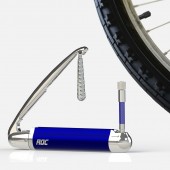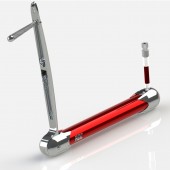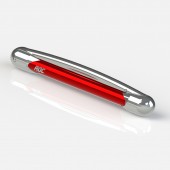DESIGN NAME:
ROC
PRIMARY FUNCTION:
Rotary Compact Cycle Pump
INSPIRATION:
Pumped Ltd was formed by Gareth Bristow and Philip Pike in 2012 to exploit the mechanical advantages of an innovative patented mechanical device, designed by Gareth, that converts a single rotary action into multiple linear movements, with obvious uses for air and fluid displacement. With numerous markets and industrial sectors that would benefit from highly efficient and compact pumps, it was decided that the initial focus would be on a segment of the leisure market Gareth and Philip know very well.
Drawing upon their years of experience as cycling enthusiasts, Philip and Gareth are only too aware of the time and effort that is required to inflate a cycle tyre even with the best hand pumps presently on the market.
Currently the top selling small pumps require at least 8 pumping actions to achieve 1 psi of pressure and the worst requiring 20 or more pumping actions. With a mountain bike tyre requiring a pressure of 50 psi, it can take considerable time and effort to inflate a tire. They indentified a clear potential for a range of compact cycle pumps that are smaller and deliver an increased volume displacement, that result in far quicker inflation times than those presently on the market.
Gareth has now completed the design and development of a range of compact hand pumps that are smaller and deliver at least twice as much air volume per stroke than the current best mini pump design on the market.
UNIQUE PROPERTIES / PROJECT DESCRIPTION:
Innovative features include an ultra compact rotary design that produces a large pumped air volume, giving quicker inflation times and better ergonomics that making tyre inflation easier and reduced chance of breaking valve stems.
The ROC pump exploits the mechanical advantages of an innovative and new patented mechanical device that converts a single rotary action into multiple linear movements. ROC pumps are smaller and deliver at least twice as much air volume per stroke than the current best mini pump design on the market. This will give far shorter tyre inflation times with the benefit of less time fixing punctures and giving more time cycling.
A cosmetic prototype of the ultra compact pump and working model of the internal mechanism has been recently produced and the manufacture a fully functional prototype to fully test the pump’s operation against the expected specifications in currently underway.
OPERATION / FLOW / INTERACTION:
-
PROJECT DURATION AND LOCATION:
-
FITS BEST INTO CATEGORY:
Product Engineering and Technical Design
|
PRODUCTION / REALIZATION TECHNOLOGY:
-
SPECIFICATIONS / TECHNICAL PROPERTIES:
ROC Ultra Compact hand pump
Dimensions closed: - 172mm x 38mm x 25.4mm
Dimensions open: - 200mm x 160mm x 25.4mm
Weight:- 190 grams
Volume displacement
1 way version:- 68,000mm3
2 way version:- 128,000mm3
Pressure range: - 5 -130 psi
TAGS:
ROC, hand pump, compact, product design, engineering,
RESEARCH ABSTRACT:
Drive assembly and hand pump
The present invention relates to drive assemblies and to hand pumps employing such assemblies. In particular, the invention relates to assemblies employing rotational to linear displacement conversion mechanisms.
Background of the invention
In European patent EP2210014B1, a rotary to linear displacement conversion mechanism is described in which a stack of alternately mounted driver and driven discs are mounted for translation on a common central axis.
The discs have complementarily shaped ramped surfaces, which, in one state, are snugly interengaged so that the stack is of minimum length. The driven discs are constrained against rotation so that when the driver discs are rotated together, the resulting camming action of the ramped surfaces of the discs on each other causes the stack to expand. The driver discs are coupled for rotation together in such a way as to permit them to separate linearly. A return spring restores the stack to its original length when the ramped surfaces ride over each other and the two types of discs return to their fully inter-engaged state.
The coupling mechanism for coupling the driver discs together consists of projections extending axially from each driver disc through bores in the intermediate driven discs to locate slideably in a recess in a proximate driver disc so that rotational drive can be transmitted between the driver discs while at the same time permitting translation.
The driven discs are constrained against rotation by means of peripheral lugs, which engage in grooves in a surrounding support structure, for example a cage, barrel or other casing.
One possible application of such a displacement mechanism to a hand pump is described in which the disc stack and return spring are contained within a fixed length barrel and the rotation is provided by means of a crank handle, connected to a drive shaft with a profiled end portion which engages a first driver disc.
and
A hand pump comprises a rotary to linear displacement conversion mechanism for driving a piston within a barrel and a crank extending transversely of the barrel and connected to the input portion of the displacement mechanism at one end to enable manual rotation thereof. The crank is articulated in a radial plane with respect to the barrel axis so that it can be folded away alongside the barrel when not in use.
Displacement is effected by rotation of driver discs on a shaft which act to cam apart interleaved driven discs. The shaft is of non-circular cross section to cause rotation yet allow translation of the driver discs whereas the driven discs are constrained against rotation. This constraint is provided by making the barrel cross section and driven discs non-circular. The inner barrel wall is smooth to facilitate good sealing.
CHALLENGE:
-
ADDED DATE:
2012-09-23 13:08:43
TEAM MEMBERS (2) :
Gareth Bristow Designer / Technical Director and Philip Pike Commercial Director
IMAGE CREDITS:
Gareth Bristow, 2012.
|










